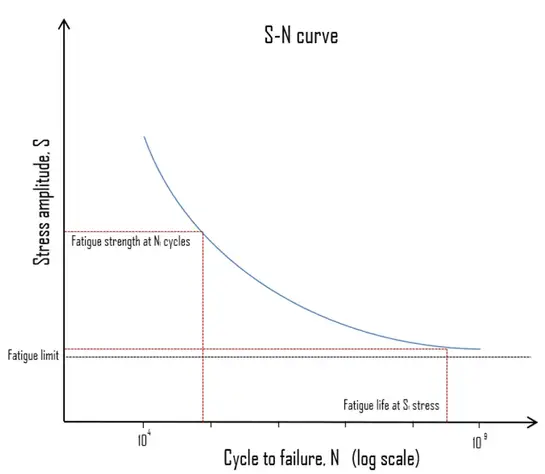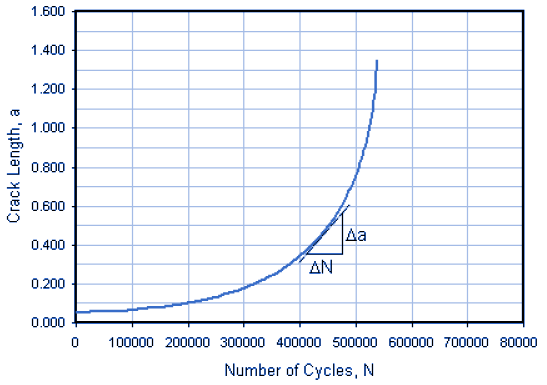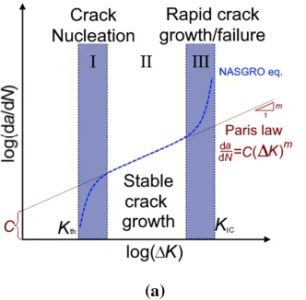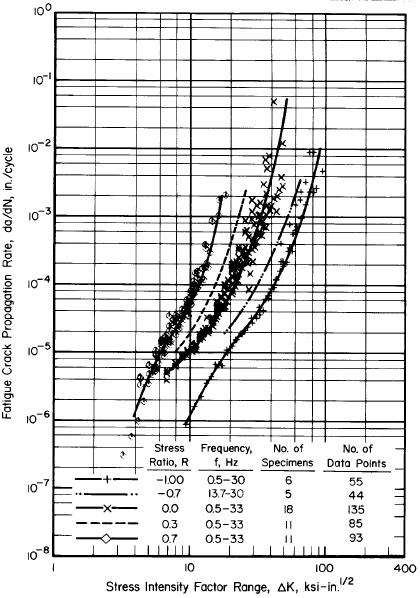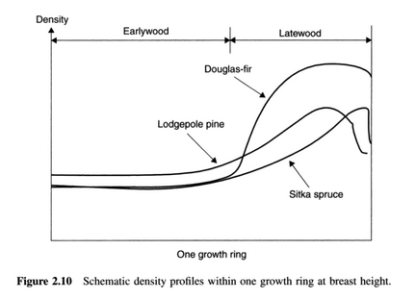Hello all,
Been following this thread with interest for a while. If I may, and if anyone is interested, I have
some understanding of material science as I am an engineer. Though it isn't my specialty. Nonetheless I want to talk about fatigue in materials.
What is fatigue?
A lot of you are quite right in that materials weakens over time. ALL materials (not just our precious soundboards) will undergo fatigue when subjected to cyclic loads. (Cyclic loads are loads that are applied, then removed, then applied again etc.) Whether it be an engine belt, bolts in a bridge, masts on a sailboat... the list goes on.
You may get a very brief summary on fatigue cracking
here. To summarize, if we subject stress on a material, over many cycles, (such as the vibration induced into the soundboard), over time, tiny tiny cracks will develop in the material. The higher the stress, the less cycles it takes for the material to fail. Makes sense, if we push hard with a palm into the soundboard (please don't do this), it may only take a few pumps to break it. As the stresses we subject it to are relatively small, the number of cycles to break the material will be a lot.
In the microscopic level, cracks are slowly growing in length as it's subjected to more cycles. As an example, imagine you put a little tear in the middle of an edge of a piece paper. You hold the paper with both hands on either side of the tear. You then slowly move your hands apart and together, each time your hands move apart, the tear grows a little. This is called crack propagation. The crack is growing.
How many cycles to failure?
Fear not, the first graph is a logarithmic graph, it's actually really stretched out if we display the scale in a linear fashion. For the relatively low stresses on the ukes, it'll take A LOT of cycles to failure. No need to worry!
We can take a look at Stradivarius violins and they still exist, though I know many of them have repaired cracks. I don't have data on the cause of the cracking though and can't say for sure it's due to fatigue crack propagation.
I found the observations of
@BradDonaldson really fascinating of the few instruments converging over time. I think this makes sense in my mind as you get crack nucleation, then crack growth over time. So the more quiet ukes went through a more steeper crack growth (area I) and then all the ukes end up at different points in a gentler slope in stable crack growth (area II), in which they will sit for pretty much the remaining lifetime of the uke. (This is my conjecture and personal guess though! I can be very wrong! Anyway back to the science.)
View attachment 152199
Cycles vs Time
When we ask the question, does wood "open up", it might be helpful to define the number of cycles rather than time. A musician playing 4 hrs a day for 20 years will subject the wood to more cycles than another player that strums for 30 min. a day for 6 months. The former instrument will have undergone more cycles and thus, one will expect to see more fatigue cracking in the microscopic level. Please think about whether this factor alone will make everyone have wildly different experiences to each other in this topic.
Stresses make a difference! How hard do you play?
A hard strummer will induce more stresses compared to a gentle fingerstylist. From the first graph, can you see how different uses of the instrument can dictate where you sit on the curve. From the graph below, it is aluminum, but you can see the higher stress will result in higher crack propagation rate!
How does this differ to Ultimate strengths?
There was some confusion and comments before that the forces aren't strong enough to permanently change the wood. Otherwise the wood will break. I understand this line of thinking. This warrants a small discussion.
When talking about materials, let's look at the graph below, stress starts at zero and goes up on the Y axis. If we subject stress on a material, up to the point B (yield strength), the material will snap back with no permanent deformation. This is known as the elastic range. Think of a stretching a rubber band slightly or bending a wooden ruler very gently. The gradient or how steep this curve is called the stiffness. The stiffer the material, the steeper, it is, the B point will be higher.
Woods have varying degrees of stiffness based on species. I should mention that stress in engineering terms means a force divided by an area. You can imagine poking someone will hurt more than pushing someone with both hands with the same amount of force, simply because the area it is applied is smaller (stress = F/A ... If F same... A low... stress high.... if A high e.g. 100, stress low).
Given the same piece of wood, if you make the piece thicker, given the same amount of
force, because there's more cross section area (A), the stresses are
lower. Luthiers will need to judge to determine the thickness of the soundboard, to ensure it stays in the elastic region.
Once the material exceeds point B, we are outside the elastic region, even if we release the stress, the material will not snap back to its original shape or length, permanent damage is done to the material. (Think stretching a rubber band too hard, it becomes looser once you let go).
When stresses are at point C, the material has reached its ultimate strength, in which it'll start to deform rapidly such as stretching and thinning out, until it breaks at point D.
This is
not the normal mode of failure for our instruments. Only luthiers will encounter this. Perhaps there wasn't enough bracing to provide stiffness or the soundboard was way too thin, in which it'll collapse within itself like a dying star as soon as it's strung up. In summary, the forces and thus stresses induced on the wood isn't enough to cause it to fail in the ultimate strength mode. Fatigue cracking occurs at much
lower stresses over many cycles. So yes, changes can occur.
Combining Everything
Combining everything, Here is an example for testing on
Pinus pinaster Ait. wood. You will see the stress/strain graph with ultimate load at 220 N, the cycles and propagation rates can be modelled. We can get very rough durability indications here. (No acoustic findings to be inferred from this data though!)
Wood is not a homogeneous material
You can consider wood as an organic polymer. It isn't uniform or homogeneous like metals. I guess everyone knows this. Not accounting for the different species, the grain direction of the cut, temperature the tree was grown in, sunlight it received, ...( list goes on), will affect the internal structure of the wood. The internal structure varies a lot even within a single piece of wood. Therefore, the internal cracking, stress planes, direction the cracks will propagate etc.
cannot be generalized.
View attachment 152200
Modelling fracturing in wood is highly difficult, and maybe in the realms of a phD level. However, given we can't really replicate the same piece of wood, or reproduce the results in the models, is there any value in examining this?
What's not in the scope of this lengthy post
- Effect of the build/construction - glue, joints, bracing etc.
- Internal stresses induced by changes in humidity/temperature, but cracks will occur from this as we all know.
- Effects on acoustics
The million dollar questions
- Do fatigue cracks improve the sound? Or does it degrade it?
- Keep in mind these are microscopic cracks! Are fatigue cracks at a length or magnitude where it has an effect?
- Cracks can join up over time - Is there a further change when this happen?
- Do joined up cracks result in a more flexible soundboard or cause the soundboard to act like a thinner one?
- Do laminated woods/double tops etc. slow down fatigue cracks?
- Are the voids from the cracks in the wood creating overtones or 'little echo chambers'?
- Does sound quality deteriorate when cracks get to a certain length?
- Can the human ear perceive the differences if there are any?
Hahaha I guess I've made everyone read a lot with no solid conclusions or solutions to offer. Maybe even more questions to boot.
I've tried my best to segregate my opinions to what is a known. Objective and commonly observed behavior of materials from a material science point of view. Many engineers will have learnt this in their studies. I'm sure there are a few of you in here. Let me know if I am wrong in anything. I don't mind! If you are a material scientist, I would love to know your thoughts! Hope I didn't offend anyone here, just offering my 2 cents.
You can read more about fatigue and fracture of woods in book below. It talks about the macrostructure more in which I am no expert, but it is fascinating!
Fracture and Fatigue in Wood
Ian Smith, Eric Landis, Meng Gong
Damage in wood is principally the result of fatigue. Fatigue is the process of progressive localised irreversible change in a material, and may culminate in cracks or complete fracture if conditions that initiated or propagated the process persist. Comprehensive understanding of fatigue and...

www.wiley.com

